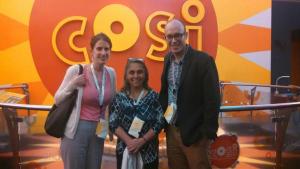By Jaclyn Jansen
For any good public information officer (PIO), the goal is pretty simple: tell people about the research going on at your institution. Typically, this means writing a press release and sending it to journalists. But PIOs are increasingly looking for alternative ways to connect with the public. NASW’s session “Beyond the News Release Grind,” moderated by Karen Kreeger, senior science communications manager for Penn Medicine, offered many creative and powerful ideas.

Audiovisual materials offer another opportunity to communicate science. Melissa Lutz Blouin, director of news and publications at University of Florida Health, partners with a local radio station to produce two daily podcasts about health and animals that are broadcast in markets across the nation.
So what does it take to make a successful show? A good producer is essential as well as a unique personality and angle for the show. Blouin uses a combination of in-house and freelance writers for the scripts, which are then vetted by an expert in the field. Judging by internet traffic alone, the podcasts have been extremely successful, generating 53,000 hits so far in 2014.
Videos provide similar exposure, with an opportunity for high visibility in both social and traditional media outlets. Evan Lerner, a science news officer at the University of Pennsylvania, suggested using videos not just for compelling storytelling, but also to explain complex topics. Making a good video requires creative ideas, talented staff, and dedicated time, according to Blouin. But surprisingly, Lerner has found that unpolished videos frequently do as well or even better than highly produced work.
Science Cafes provide a new forum for scientists to present their work to the public, fostering community and faculty relations. Often a very short talk followed by questions from the audience, the meetings get scientists out of the lab. Finding the right location is the biggest challenge, according to Katie Baillie, a science news officer at the University of Pennsylvania. The venue needs a low noise level, good lighting, the right technical capabilities, and a receptive crowd.
Another way to get researchers into the community is to team up with a local science festival. Hands on experiments offer a unique “fun factor” said Josette Hammerstone, a production manager at the Philadelphia Science Festival and The Franklin Institute. These festivals allow numerous local institutions to pool their resources, generating positive press and improving relationships. Looking for places to start? Check out Portal to the Public, How to Smile, and the Science Festival Alliance.
